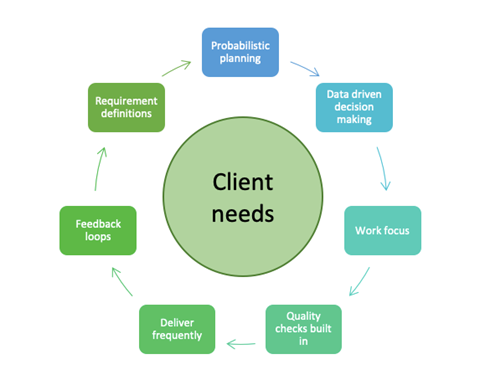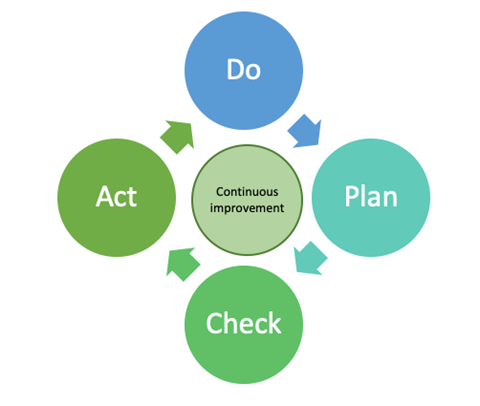Module 9. Agile project governance
Overview
Agile project management is the delivery of requirements through an iterative and incremental manner. It is based on the division of tasks into short phases and pieces of work, frequent assessment, reassessment and changing of plans as needed. Being agile is a mindset, which is based on reducing difficulty of project management and planning, developing the project, implementing it, and testing the project.
The Agile Manifesto (2001) is based on four primary values:
- Individuals and interactions over processes and tools.
- Working software over comprehensive documentation.
- Customer collaboration over contract negotiation.
- Responding to change over following a plan.
These values highlight the importance of the factors to the left in contrast to those on the right, which are typical of waterfall project management. According to these values, organisations need to ensure that they are working collaboratively with stakeholders to ensure that there is alignment between the outcomes proposed and achieved (Alahyari et al., 2016). In addition, there is a significant need to build trust, commitment, identity, visibility, and leadership (Chikhale & Mansouri, 2015).
From these values flow agile governance, which follows the same principles of being iterative and flexible. Agile governance utilises rapid decision-making, using governance processes that are of minimum effort and do not require arduous front-end work to complete. Governance points are identifiable within the process, including authority, standard practices, metrics, and artefacts, which are outlined at the beginning of the planning phase. Therefore, for agile governance to occur there needs to be (Disciplined Agile Consortium, 2014):
- collaboration over conformance
- enablement over inspection
- continuous monitoring over quality gates
- transparency over management reporting.
Therefore, collaboration is vital within and outside the organisation, commitment obtained from stakeholders needs to promote transformation, adaptation and flexibility, and an alignment with organisational strategies and business plans are required.
Brunet and Aubry (2016) showed that agile project governance is a value system where a project operates, and where the project’s roles, responsibilities and processes required to meet objectives and procedures require adherence. Brunet and Aubry (2016) showed the importance of stakeholders’ involvement to manage the process, and to ensure uncertainties and challenges are managed. Due to the changing nature of agile management, many challenges can arise, including lack of coordination, backlog mismatches, team misalignment, unpredictable delivery, and information not being visible (Vlietland & van Vliet, 2015).
The primary issues that need to be responded to include a lack of governance tools to control the project work, and managing processes rather than people (Lappi & Aaltonen, 2016). It is documented that traditional or waterfall governance methods do not align with agile project needs.
Research highlights several guiding principles (de Luna et al, 2014):
- Agile project management needs to align with organisational goals.
- Organisational leaders need to understand the value that agility can offer their organisation prior to implementation.
- Governance and performance measures need to be clear and monitored continuously.
- Expectations need to be clearly defined, especially based on the organisation’s timeframes, resources, and skills.
- Risk management processes should be clearly defined at the onset.
- Monitoring and controlling performance metrics need to be clear and transparent throughout the organisation, project team, stakeholders, and the clients.
- Regulatory requirements must be met.
- Reviews should be undertaken to ensure that the agile project methodology and projects completed meet the needs of the organisation.
Agile project governance follows the agile principles of project management. There are a few challenges associated with the governance of projects using the agile process and many of the governance principles outlined in previous modules should be applied to support the outcomes of agile projects.
Agile project management principles and agile governance
Agile project management has twelve principles used to clarify the four values outlined previously and within the Agile Manifesto (Beck et al., 2001).
-
Satisfy clients through early and continuous delivery (of value).
Principle 1 highlights the early and continuous delivery of outcomes and requires the management of people within the project team, clients, and outside the team:
- Change management processes based on sharing information across the team, clients and key stakeholders must solve problems or respond to blockers as they arise. Documentation should identify the blockers that arise in a similar risk or issues management process that would be applied in project governance techniques used for waterfall project management.
- Share outcomes in iterations, and through these iterations encourage feedback from clients to ensure each iteration improves on the last.
To keep clients happy, the project team should be engaging with them through each incremental improvement, along with the planning at each phase.
-
Welcome changing requirements, even late in development.
Principle 2 focuses on the documentation requirements and the change management processes that are utilised in agile projects. This requires:
- Streamlining documentation, with a focus on the design and development of key tasks or activities which link to specifics within the product or service being developed. Workshops are used to define and refine requirements, and these discussions should be documented.
- Building quickly, through shorter discovery and definition periods. Planning stages involve collaboration through workshops prior to each increment and completing the project plan progressively.
- Utilising prototyping, including testing at each stage from minimum viable product all the way to most desirable outcome.
- Delivering progressively to the end user. Through this progressive provision there needs to be ongoing reviews, planning phases and updates within each increment. This planning phase should focus on any potential blockers and how they can be best improved.
Agile projects can be complex projects, which are handled by dividing tasks into smaller parts until they are easily completed. During this process, share updates and improvements with clients and team members to ensure they are happy with the progress and can support addressing any blockers.
-
Deliver frequently.
Principle 3 is about spending less time on upfront planning and more time working on the outcomes of your project. Figure 24 shows the agile planning process, which is cyclical.

As previously stated, agile project planning is iterative and added to progressively, based on the next sprint or increment. The project plan should incorporate:
- client values, their goals, and requirements
- define major project deliverables
- break down into tasks
- frequent deliveries
- probable due dates based on date ranges instead of fixed dates
- work and responsibilities assigned to the project team, not to specific individuals
- quality built into the process
- two sets of plans:
- (1) timelines and date ranges for the different initiatives and increments
- (2) list of tasks and activities, outlining sequences and dependencies that have no start and end date but have time frames associated with how long completion will take, and resources and material required
- utilising historical project information to support planning (e.g., data driven)
- training for the team in agile management principles:
- ease the team into it, including clients and stakeholders
- collaborate in the requirements discussion, analysis and design, implementation, and feedback.
The agile philosophy favors a smaller time frame and frequent deliverables. This iterative process requires team members to continuously improve their performance.
-
Break project silos.
Principle 4 is the use of cross-functional teams, who can communicate well with stakeholders and team members who do not have the specific skill sets. This includes changing the names of project roles and responsibilities to clarify the positions, while creating synchronisation between the developers, designers, and the implementers. It also requires the development of strategies for internal collaboration, to ensure that the project team has a process in place to determine how to communicate, co-design and best work together.
Stakeholders are encouraged to remain involved in each increment, ensuring ongoing feedback and buy-in for the product.
-
Build projects around motivated individuals. Give them the environment and support they need, and trust them to get the job done.
Principle 5 requires the project manager to motivate the team, by providing a supportive and collaborative environment that encourages project team members to speak up, provide feedback and suggestions and perform at their best. Team performance should still be monitored and tracked; however, the team should have the confidence to manage their own performance.
-
Face-to-face communication is the most efficient and effective method.
Principle 6 is the engagement process utilised for communication within the project and outside it. This includes how to communicate effectively and while there are numerous methods, within agile the preferred method is face-to-face (or when not co-located, video conferencing). This is not to say that written communication is not important (e.g., emails, memos), which are used to confirm the details within the face-to-face discussions. Like traditional project management governance, a communication and engagement plan should be developed at the onset of the project to document who the stakeholders are, how they will be communicated with, when and why and who will review the process.
-
Working deliverables are the primary measures of progress.
Principle 7 is the use of success and performance measures, which are primarily based on the development of a working product, service, or software. There are other measures of success and performance which are important, including team performance, timelines, and resource management. These need to be measured and reported on frequently.
-
Maintain sustainable working pace.
Principle 8 involves setting a pace and timeline that is achievable. It requires discussing and understanding the different requirements and deliverables, broken down by tasks and activities, and linking them to the available resources and materials to achieve the next outcome. As agile requires constant development, the pace established at the beginning should not be overwhelming or unachievable. To develop this pace, expert judgment and data from historical projects should be applied to understand the achievable pace, and any potential risks or blockers which could arise and the impact they could have on the outcomes.
Develop and share with stakeholders and clients the project roadmap, which outlines the trajectory to get to the end state. This should be indicative of the steps required to get to the minimum viable product and the desired end state.
-
Continuous improvement and excellence enhance agility
Principle 9 involves having ongoing client conversations to learn from testing and feedback.
Focusing on the deliverables, continuous improvement should consider the design, technical aspects, project methods and value to clients. Therefore, continuous improvement should be based on understanding how delivery can add value to the client, organisation, team, and stakeholders more broadly. It is useful to utilise different feedback and testing mechanisms to understand different improvements.
This requires solid change management processes and requires documentation of the different changes implemented and how they impacted deliverables.
-
Simplicity is essential
Principle 10 outlines the need for simplicity. It is recommended that each agile project has a light plan to satisfy stakeholders. The plan is to be added to over time, to include incremental deliverables and the development of a product roadmap. The tasks in each increment should be the primary work completed by the project team members.
Therefore, using agile methodology the project manager should utilise a time, materials and resources scope when outlining what is needed to obtain the outcome, which can support the development of contracts.
-
Self-organising teams create the most value.
Principle 11 states that self-organising teams are those who do not wait for someone to assign work to them. Instead, these teams are aware of their responsibilities, roles and requirements and manage the work they must complete to ensure the deliverables are on time or in line with the plan. Decision-making powers in these teams are shared across different members in the team and the primary outcome is creating value for the clients.
-
Reflect regularly and adjust your way of work to become more effective.
Principle 12 is based on iteration, encouraging learning from previous work and continuous improvement. This can be based on the lean process for continuous improvement (Womack et al. 1990), outlined in Figure 25.

Utilising the continuous improvement model from lean project management, asks the team’s project manager to hold workshops with the project team to reflect on their performance and discuss the lessons they learned, to improve their technical skills, project management skills and their communication more broadly. The lean model asks teams to plan their work, complete their work, check how they went compared to the plan, and document improvements and start planning again.
Let’s revise some of the key concepts:
Agile project governance: Benefits and challenges
There are several benefits to using agile project management and governance principles (Masood & Farooq, 2017). These include:
- rapid delivery of outcomes
- reduced resource waste
- flexibility and adaptability
- increased success through incremental delivery
- progressive identification of issues and defects and appropriate solutions
- optimisation of development processes
- streamlined project control
- focus on client needs
- collaboration and feedback.
In contrast, there are several challenges associated with the use of agile project management and governance principles (Masood & Farooq, 2017), including:
- not well suited to every project and organisation
- not suited to projects with unclear goals
- inexperienced project managers or team members
- teams who do not work well under pressure
- end user experience can be lost on the requirement building
- not easily followed in large organisations.
Agile governance best practices
Through the adoption of agile principles, there are several best practices which can be used to support the governance process.
- Ensure agile project management processes fit organisational needs. This includes processes, practices, documentation, and strategic direction.
- Ensure continuous reporting to organisation, clients, and stakeholders on progress, iterations and value created.
- Clients and project teams should communicate any changes in the environment or business conditions that could impact the outcomes.
- Provide training and education to the project team, clients, and stakeholders on agile project management to ensure they understand the processes.
- Performance metrics need to be set from the onset. They may include incremental deliverables, resource use and team performance.
- Have a clear and easy to follow change management process in place for each agile project.
Reading: Agile and project governance: Can they coexist?
Integrating governance into the agile project approach is not a new concept. Mike Cohn’s article about agile and governance discusses both concepts and in particular addresses a key question: Can governance work into agile projects? Please click the link below to read his article and reflect on the stage-gate process he highlights in the article.
Key Takeaways
- Good governance, particularly when using agile, is more about the decision-making process, not what the decision is about.
- The Agile Manifesto (2001) is based on four primary values: 1) individuals and interactions over processes and tools, 2) working software over comprehensive documentation, 3) customer collaboration over contract negotiation, and 4) responding to change over following a plan.
References
de Luna, A. J., Kruchten, P., Pedrosa, M., de Almeida Neto, H., & de Moura, H. (2014). State of the art of agile governance: A systematic review. International Journal of Computer Science & Information Technology, 6(5).
Alahyari, H., Svensson, R. B., & Gorschek, T. (2016). A study of value in agile software development organisations. The Journal of Systems and Software, 125, 271-288.
Beck, K., Beedle, M., van Bennekum, A., Cockburn, A., Cunningham, W., Fowler, M., Grenning, J., Highsmith, J., Hunt, A., Jeffries, R., Kern, J., Marick, B., Martin, R. C., Mellor, S., Schwaber, K., Sutherland, J., & Thomas, D. (2001). Manifesto for agile software development. http://agilemanifesto.org/principles.html
Brunet, M., & Aubry, M. (2016). The three dimensions of a governance framework for major public projects. International Journal of Project Management, 34(8), 1596-1607.
Chikhale, M., & Mansouri, M. (2015). An agile and collaborative framework for effective governance to enhance management in large-scale enterprise business systems: The case of Apple Inc. Global Journal of Flexible Systems Management, 16.
Disciplined Agile Consortium. (2014). A solid foundation for business agility with Disciplined Agile. https://www.pmi.org/disciplined-agile
Lappi, T., & Aaltonen, K. ( 2016). Project governance in public sector agile software projects. International Journal of Managing Projects in Business, 10, 263-294.
Masood, Z. A., & Farooq, S. (2017). The benefits and key challenges of agile project management under recent research opportunities. International Research Journal of Management Sciences, 5(1), 20-28.
Vlietland, J., & van Vliet, H. (2015). Towards a governance framework for chains of scrum team. Information and Software Technology, 57(1).
Womack, J., Jones, D., & Roos, D. (1990). The machine that changed the world: The story of lean production. HarperCollins.


